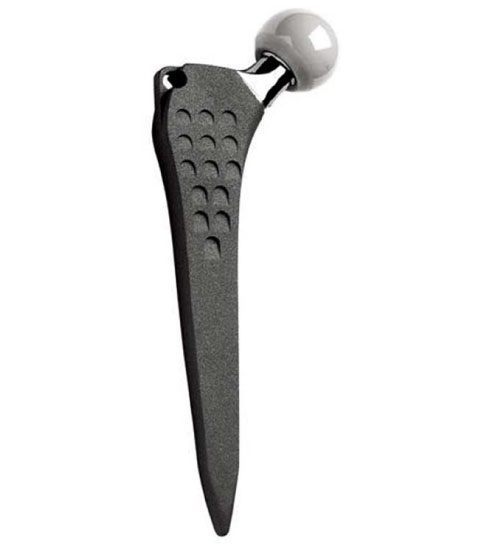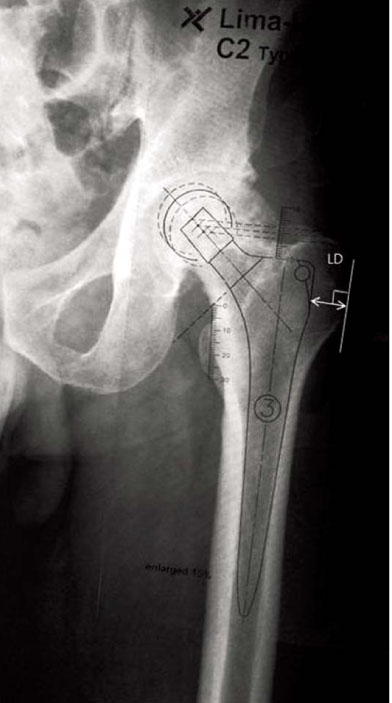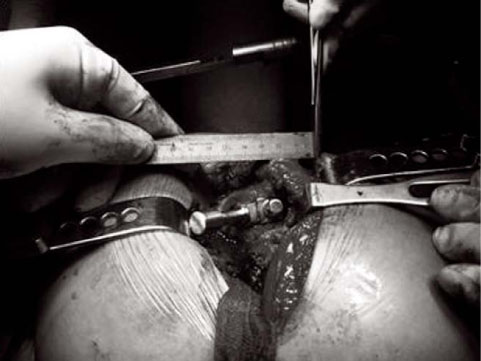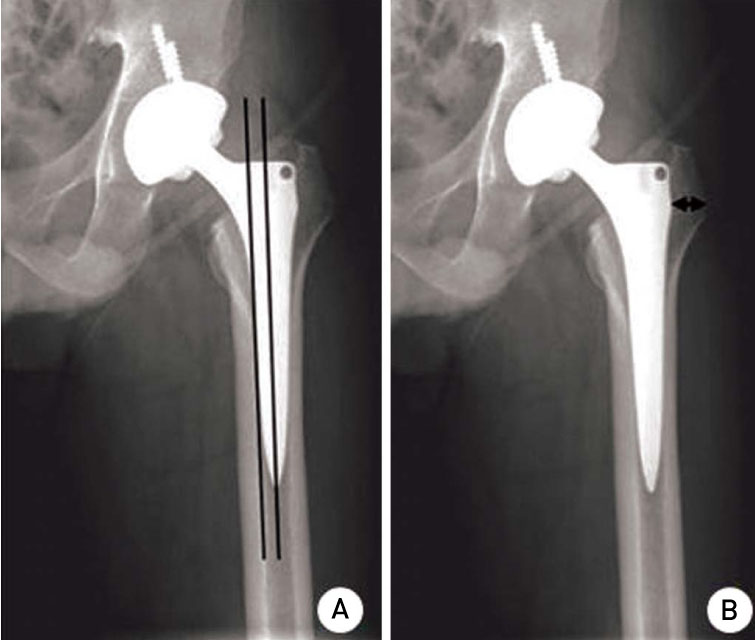Hip Pelvis.
2012 Dec;24(4):288-294. 10.5371/hp.2012.24.4.288.
Useful Method for Neutral Positioning of the Femoral Stem in Cementless Total Hip Arthroplasty
- Affiliations
-
- 1Department of Orthopaedic Surgery, Soonchunhyang University Cheonan Hospital, Cheonan, Korea. jsparksch@schmc.ac.kr
- 2Department of Orthopaedic Surgery, Soonchunhyang University College of Medicine, Seoul, Korea.
- KMID: 1425044
- DOI: http://doi.org/10.5371/hp.2012.24.4.288
Abstract
- PURPOSE
The aim of this study was to evaluate the usefulness of a method for positioning the femoral stem in neutral position refer to the measured value of "lateral distance" in pre-operative templating and the femoral stem position post-operatively.
MATERIALS AND METHODS
A total of 81 hips in 76 patients underwent cementless total hip arthroplasty between March 2008 and April 2012 using the C2 stem (Lima Corporate S.P.A, Udine, Italy). We measured the perpendicular distance from the lateral outermost part of the greater trochanter to the lateral outermost part of the femoral stem (lateral distance, LD) in pre-operative templating. We aimed to insert the femoral stem in neutral position by comparing LD measured intra-operatively. We evaluated the position of the femoral stem on post-operative plain radiography. We compared the result of post-operative re-measurement of the LD with that of pre-operative measurement.
RESULTS
In all of the 81 cases, the femoral stem was inserted in neutral position, defined as the femoral stem position within 3degreesvalgus or varus. The average angle of the inserted femoral stem was 1.20degrees(0.003-2.85degrees). LD measured in preoperative templating was 15.6 mm(10-21.5 mm), and it showed no correlation ratio with LD; LD re-measured post-operatively was 15.9 mm(10.3-23.5 mm) (P=0.781).
CONCLUSION
Measuring LD pre-operatively and using the value intra-operatively is an effective method for insertion of the femoral stem in neutral position.
Keyword
MeSH Terms
Figure
Reference
-
1. McBeath AA, Foltz RN. Femoral component loosening after total hip arthroplasty. Clin Orthop Relat Res. 1979. (141):66–70.
Article2. Vresilovic EJ, Hozack WJ, Rothman RH. Radiographic assesement of cementless femoral components. Correction with intraoperative mechanical stability. J Arthroplasty. 1994. 9:137–141.3. Munuera L, Garcia-Cimbrelo E. The femoral component in low-friction arthroplasty after ten years. Clin Orthop Relat Res. 1992. (279):163–175.
Article4. Mallory TH, Head WC, Lombardi AV Jr, Emerson RH Jr, Eberle RW, Mitchell MB. Clinical and radiographic outcome of cementless, titanium, plasma spray-coated total hip arthroplasty femoral component. Justification for continuance of use. J Arthroplasty. 1996. 11:653–660.
Article5. Xenos JS, Callaghan JJ, Heekin RD, Hopkinson WJ, Savory CG, Moore MS. The porous-coated anatomic total hip prosthesis, inserted without cement. A prospective study with a minimum of ten years of follow-up. J Bone Joint Surg Am. 1999. 81:74–82.
Article6. Kosashvili Y, Shasha N, Olschewski E, et al. Digital versus conventional templating techniques in preoperative planning for total hip arthroplasty. Can J surg. 2009. 52:6–11.7. Suh KT, Cheon SJ, Kim DW. Comparison of preoperative templating with postoperative assessment in cementless total hip arthroplasty. Acta Orthop Scand. 2004. 75:40–44.
Article8. Kim MS, Jeong MC, Ji NG, Lee JS, Kim JI, Suh KT. Preoperative templating in PACS for total hip replacement. J Korean Orthop Assoc. 2011. 46:472–477.
Article9. Hwang SK, Kang DH, Cho TY, Lee CH. Comparison of conventional digital templating technique in total hip arthroplasty. J Korean Hip Soc. 2010. 22:73–78.
Article10. Burkart BC, Bourne RB, Rorabeck CH, Kirk PG. Thigh pain in cementless total hip arthroplasty. A comparison of two systems at 2 years' follw-up. Orthop Clin North Am. 1993. 24:645–653.11. Bourne RB, Rorabeck CH, Patterson JJ, Guerin J. Tapered titanium cementless total hip replacements: a 10- to 13-year followup study. Clin Orthop Relat Res. 2001. (393):112–120.12. Sinha RK, Dungy DS, Yeon HB. Primary total hip arthroplasty with a proximally porous-coated femoral stem. J Bone Joint Surg Am. 2004. 86-A:1254–1261.
Article13. Sakalkale DP, Eng K, Hozack WJ, Rothman RH. Minimum 10-year results of a tapered cementless hip replacement. Clin Orthop Relat Res. 1999. (362):138–144.
Article14. Mallory TH, Lombardi AV Jr, Leith JR, et al. Minimal 10-year results of a tapered cementless femoral component in total hip arthroplasty. J Arthroplasty. 2001. 16:49–54.
Article15. Khalily C, Lester DK. Results of a tapered cementless femoral stem implanted in varus. J Arthroplasty. 2002. 17:463–466.
Article16. Min BW, Song KS, Bae KC, Cho CH, Kang CH, Kim SY. The effect of stem alignment on results of total hip arthroplasty with a cementless tapered-wedge femoral component. J Arthroplasty. 2008. 23:418–423.
Article17. Kim SK, Park JW, Wang JH, Han JW, Song JY. Varus positioned femoral stem in cementless total hip arthroplasthy. J Korean orthop Assoc. 2007. 42:586–592.
Article18. Pellegrini VD Jr, Hughes SS, Evarts CM. A collarless cobart-chrome femoral component in uncemented total hip arthroplasty. Five-to eight-year follw-up. J Bone Joint Surg Br. 1992. 74:814–821.19. Smith SE, Garvin KL, Jordan OM, Kaplan PA. Uncemented total hip arthroplasty. Prospective analysis of the tri-lock femoral component. Clin Orthop Relat Res. 1991. (269):43–50.20. Gill TJ, Sledge JB, Orler R, Ganz R. Lateral insufficiency fractures of the femur caused by osteopenia and varus angulation: a complication of total hip arthroplasty. J Arthroplasty. 1999. 14:982–987.
Article21. Goodman S, Rubenstein J, Schatzker J, Kadish L, Fornasier V. Apparent changes in the alignment of the femoral component in hip arthroplasties associated with limb positioning. Clin Orthop Relat Res. 1987. (221):242–245.
Article
- Full Text Links
- Actions
-
Cited
- CITED
-
- Close
- Share
- Similar articles
-
- Reference Line Closer to the True Femoral Anteversion During Primary Cementless Total Hip Arthroplasty
- Varus Positined Femoral Stem in Cementless Total Hip Arthroplasty
- Total Hip Arthroplasty with F2L Multineck Cementless Femoral Stem
- Usefulness of a Modular Hip System for Combined Anteversion in Cementless Total Hip Arthroplasty
- Short-term Results after Cementless Total Hip Arthroplasty Using a Fully Hydroxyapatite-coated Femoral Stem





